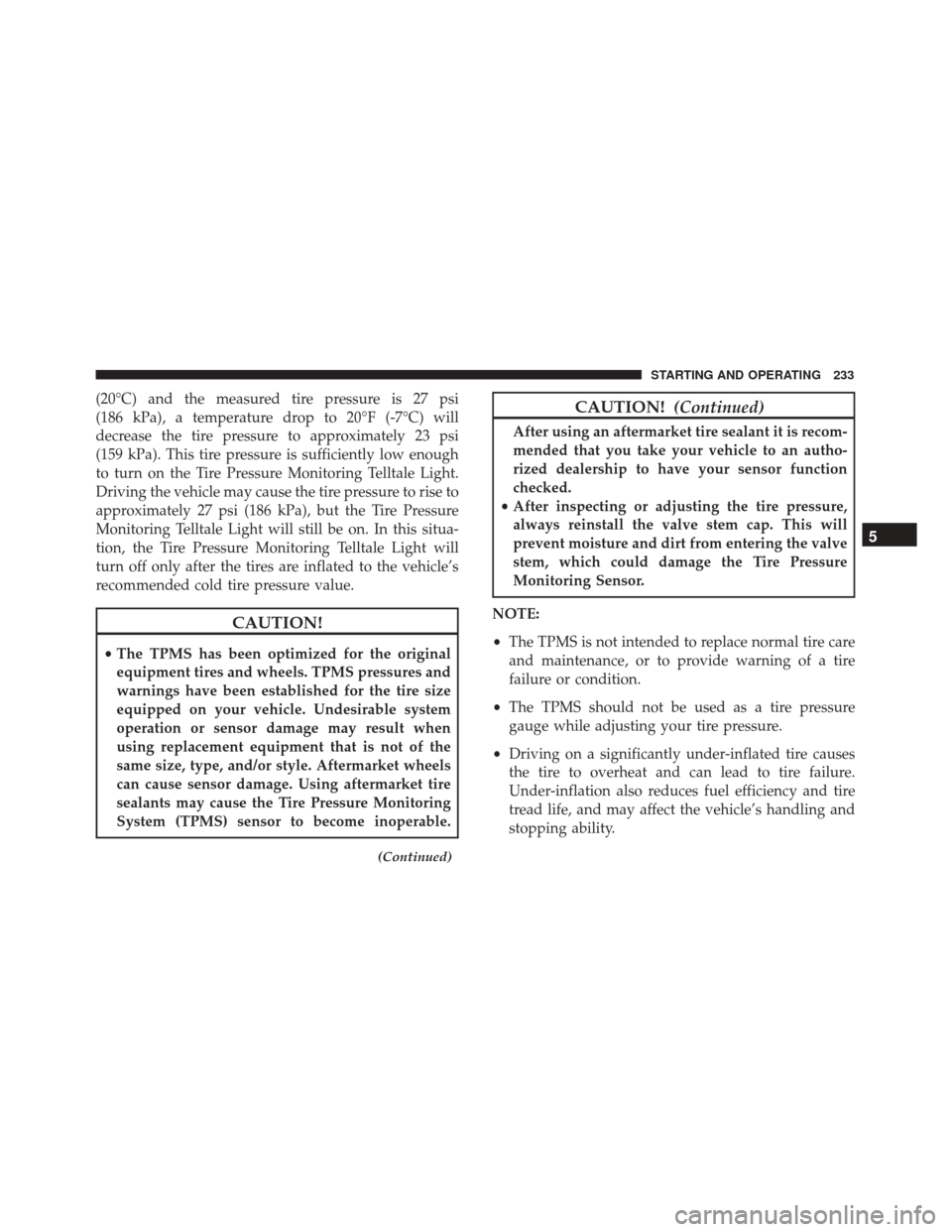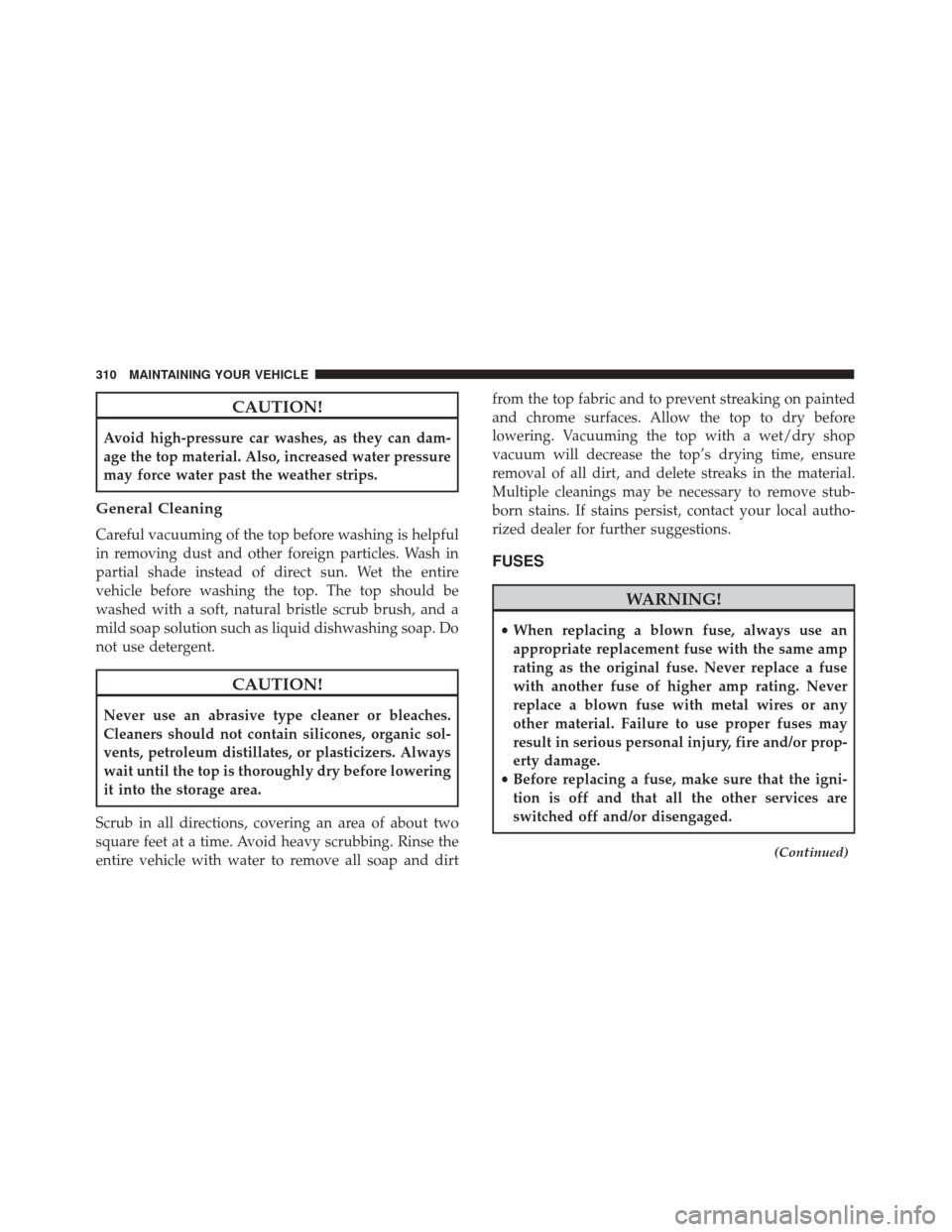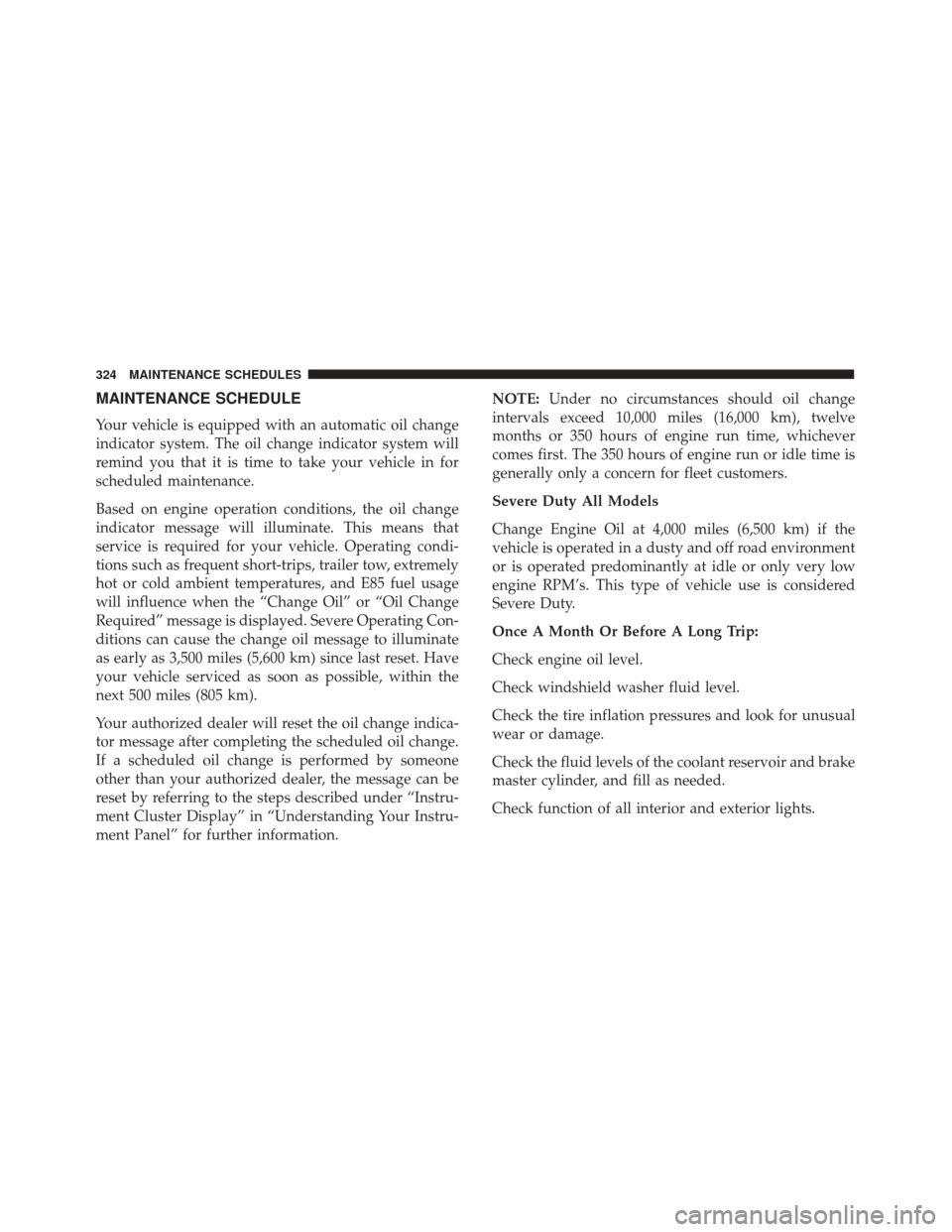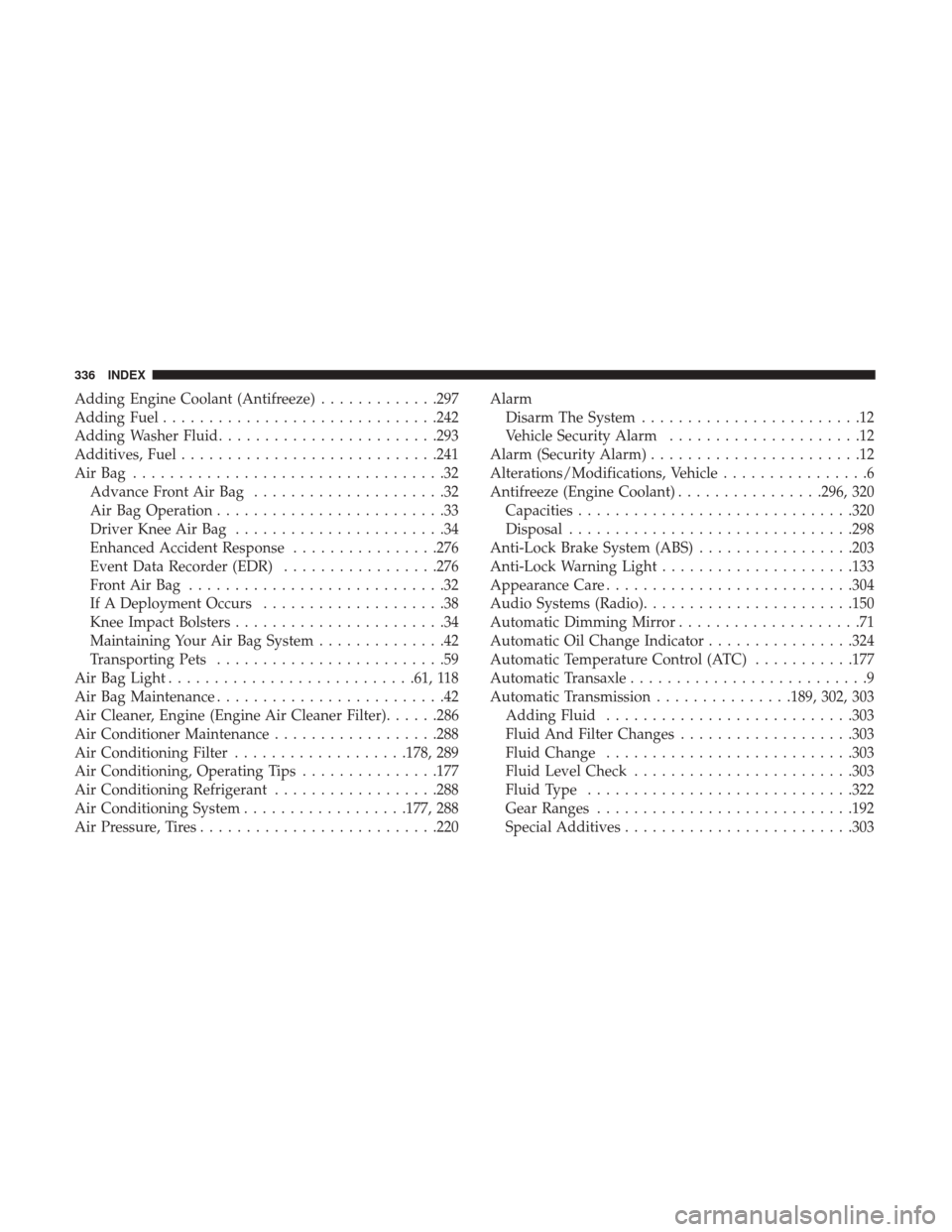tire type FIAT 500C 2017 2.G User Guide
[x] Cancel search | Manufacturer: FIAT, Model Year: 2017, Model line: 500C, Model: FIAT 500C 2017 2.GPages: 350, PDF Size: 3.01 MB
Page 235 of 350

(20°C) and the measured tire pressure is 27 psi
(186 kPa), a temperature drop to 20°F (-7°C) will
decrease the tire pressure to approximately 23 psi
(159 kPa). This tire pressure is sufficiently low enough
to turn on the Tire Pressure Monitoring Telltale Light.
Driving the vehicle may cause the tire pressure to rise to
approximately 27 psi (186 kPa), but the Tire Pressure
Monitoring Telltale Light will still be on. In this situa-
tion, the Tire Pressure Monitoring Telltale Light will
turn off only after the tires are inflated to the vehicle’s
recommended cold tire pressure value.
CAUTION!
•The TPMS has been optimized for the original
equipment tires and wheels. TPMS pressures and
warnings have been established for the tire size
equipped on your vehicle. Undesirable system
operation or sensor damage may result when
using replacement equipment that is not of the
same size, type, and/or style. Aftermarket wheels
can cause sensor damage. Using aftermarket tire
sealants may cause the Tire Pressure Monitoring
System (TPMS) sensor to become inoperable.
(Continued)
CAUTION! (Continued)
After using an aftermarket tire sealant it is recom-
mended that you take your vehicle to an autho-
rized dealership to have your sensor function
checked.
• After inspecting or adjusting the tire pressure,
always reinstall the valve stem cap. This will
prevent moisture and dirt from entering the valve
stem, which could damage the Tire Pressure
Monitoring Sensor.
NOTE:
• The TPMS is not intended to replace normal tire care
and maintenance, or to provide warning of a tire
failure or condition.
• The TPMS should not be used as a tire pressure
gauge while adjusting your tire pressure.
• Driving on a significantly under-inflated tire causes
the tire to overheat and can lead to tire failure.
Under-inflation also reduces fuel efficiency and tire
tread life, and may affect the vehicle’s handling and
stopping ability.
5
STARTING AND OPERATING 233
Page 312 of 350

CAUTION!
Avoid high-pressure car washes, as they can dam-
age the top material. Also, increased water pressure
may force water past the weather strips.
General Cleaning
Careful vacuuming of the top before washing is helpful
in removing dust and other foreign particles. Wash in
partial shade instead of direct sun. Wet the entire
vehicle before washing the top. The top should be
washed with a soft, natural bristle scrub brush, and a
mild soap solution such as liquid dishwashing soap. Do
not use detergent.
CAUTION!
Never use an abrasive type cleaner or bleaches.
Cleaners should not contain silicones, organic sol-
vents, petroleum distillates, or plasticizers. Always
wait until the top is thoroughly dry before lowering
it into the storage area.
Scrub in all directions, covering an area of about two
square feet at a time. Avoid heavy scrubbing. Rinse the
entire vehicle with water to remove all soap and dirt from the top fabric and to prevent streaking on painted
and chrome surfaces. Allow the top to dry before
lowering. Vacuuming the top with a wet/dry shop
vacuum will decrease the top’s drying time, ensure
removal of all dirt, and delete streaks in the material.
Multiple cleanings may be necessary to remove stub-
born stains. If stains persist, contact your local autho-
rized dealer for further suggestions.
FUSES
WARNING!
•
When replacing a blown fuse, always use an
appropriate replacement fuse with the same amp
rating as the original fuse. Never replace a fuse
with another fuse of higher amp rating. Never
replace a blown fuse with metal wires or any
other material. Failure to use proper fuses may
result in serious personal injury, fire and/or prop-
erty damage.
• Before replacing a fuse, make sure that the igni-
tion is off and that all the other services are
switched off and/or disengaged.
(Continued)
310 MAINTAINING YOUR VEHICLE
Page 326 of 350

MAINTENANCE SCHEDULE
Your vehicle is equipped with an automatic oil change
indicator system. The oil change indicator system will
remind you that it is time to take your vehicle in for
scheduled maintenance.
Based on engine operation conditions, the oil change
indicator message will illuminate. This means that
service is required for your vehicle. Operating condi-
tions such as frequent short-trips, trailer tow, extremely
hot or cold ambient temperatures, and E85 fuel usage
will influence when the “Change Oil” or “Oil Change
Required” message is displayed. Severe Operating Con-
ditions can cause the change oil message to illuminate
as early as 3,500 miles (5,600 km) since last reset. Have
your vehicle serviced as soon as possible, within the
next 500 miles (805 km).
Your authorized dealer will reset the oil change indica-
tor message after completing the scheduled oil change.
If a scheduled oil change is performed by someone
other than your authorized dealer, the message can be
reset by referring to the steps described under “Instru-
ment Cluster Display” in “Understanding Your Instru-
ment Panel” for further information.NOTE:
Under no circumstances should oil change
intervals exceed 10,000 miles (16,000 km), twelve
months or 350 hours of engine run time, whichever
comes first. The 350 hours of engine run or idle time is
generally only a concern for fleet customers.
Severe Duty All Models
Change Engine Oil at 4,000 miles (6,500 km) if the
vehicle is operated in a dusty and off road environment
or is operated predominantly at idle or only very low
engine RPM’s. This type of vehicle use is considered
Severe Duty.
Once A Month Or Before A Long Trip:
Check engine oil level.
Check windshield washer fluid level.
Check the tire inflation pressures and look for unusual
wear or damage.
Check the fluid levels of the coolant reservoir and brake
master cylinder, and fill as needed.
Check function of all interior and exterior lights.
324 MAINTENANCE SCHEDULES
Page 338 of 350

Adding Engine Coolant (Antifreeze).............297
Adding Fuel ............................. .242
Adding Washer Fluid ....................... .293
Additives, Fuel ........................... .241
AirBag ..................................32 Advance Front Air Bag .....................32
Air Bag Operation .........................33
Driver Knee Air Bag .......................34
Enhanced Accident Response ................276
Event Data Recorder (EDR) .................276
FrontAirBag ............................32
If A Deployment Occurs ....................38
Knee Impact Bolsters .......................34
Maintaining Your Air Bag System ..............42
Transporting Pets .........................59
Air Bag Light .......................... .61, 118
Air Bag Maintenance .........................42
Air Cleaner, Engine (Engine Air Cleaner Filter) ......286
Air Conditioner Maintenance ..................288
Air Conditioning Filter ...................178, 289
Air Conditioning, Operating Tips ...............177
Air Conditioning Refrigerant ..................288
Air Conditioning System ..................177, 288
Air Pressure, Tires ......................... .220Alarm
Disarm The System ........................12
Vehicle Security Alarm .....................12
Alarm (Security Alarm) .......................12
Alterations/Modifications, Vehicle ................6
Antifreeze (Engine Coolant) ................296, 320
Capacities ............................. .320
Disposal .............................. .298
Anti-Lock Brake System (ABS) .................203
Anti-Lock Warning Light .....................133
Appearance Care .......................... .304
Audio Systems (Radio) ...................... .150
Automatic Dimming Mirror ....................71
Automatic Oil Change Indicator ................324
Automatic Temperature Control (ATC) ...........177
Automatic Transaxle ..........................9
Automatic Transmission ...............189, 302, 303
Adding
Fluid .......................... .303
Fluid And Filter Changes ...................303
Fluid Change .......................... .303
Fluid Level Check ....................... .303
Fluid Type ............................ .322
Gear Ranges ........................... .192
Special Additives ........................ .303
336 INDEX